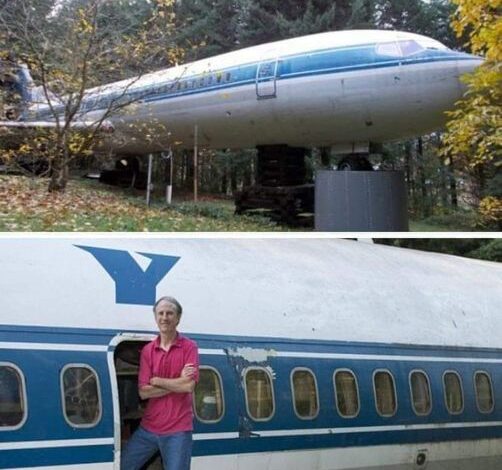Wait Until You See Inside This Man’s Home, Which He Made Out of An Airplane
Imagine turning an old airplane into a home. For 64-year-old retired electrical engineer Bruce Campbell, that dream became a reality. With his passion for innovation and a knack for creativity, Campbell transformed a retired Boeing 727 into a one-of-a-kind living space nestled in the woods near Hillsboro, Oregon. What began as a unique vision in his early twenties eventually materialized into an extraordinary home that combines functionality, sustainability, and a touch of aviation history. Let’s take a closer look at Campbell’s fascinating journey and the incredible interior of his airplane home.

A Visionary’s Unusual Dream
Bruce Campbell has always been fascinated by taking things apart and reimagining them in new and creative ways. In his early twenties, he purchased 10 acres of wooded land in Oregon for $23,000 with a bold plan to build a home like no other. His initial idea was to use a series of retired cargo ships as the foundation for his dream house. Campbell was confident his plan was entirely original until he discovered, years later, that someone else had already brought a similar concept to life.
About two decades after conceiving his plan, Campbell came across the story of Joanne Ussery, a hairdresser from Mississippi who had also turned a retired Boeing 727 into her home. After her original house burned down, Ussery decided to rebuild her life—this time in a plane situated near a serene river. Inspired by her ingenuity, Campbell decided to pivot his plan. He would still use an airplane as the core of his design, but he would make it truly his own in terms of style and functionality.
The Acquisition of a Boeing 727
In 1999, Campbell purchased a retired Boeing 727 from Olympic Airways for $100,000. The aircraft, once soaring through the skies, was now destined for a second life as a grounded home. However, acquiring the plane was only part of the challenge. Transporting the massive jet from Athens, Greece, to its final resting place in the Oregon woods was a logistical feat.
The journey was anything but simple. Campbell faced significant hurdles in moving the jet across continents and eventually into the dense Oregon forest. Factoring in transportation costs—an estimated $120,000—his total investment in the plane reached $220,000. While this might seem like a hefty price tag, Campbell believed it was worth every penny. For him, this wasn’t just a home; it was the culmination of years of planning, dreaming, and determination.
Building a Home Like No Other
Once the airplane was secured on his property, the real work began. Campbell set out to transform the jet’s interior into a livable space while preserving much of its original design and character. The cabin, once filled with rows of passenger seats, became the heart of his home. He approached the project with the precision and ingenuity of an engineer, making sure every detail served a purpose.
The interior of Campbell’s airplane home is a stunning blend of industrial charm and modern comfort. The cockpit remains intact, serving as a reminder of the plane’s history and a unique feature that adds to the home’s character. The fuselage offers a surprisingly spacious layout, with sleek lines and natural light streaming in through the original windows. Campbell has repurposed the plane’s features wherever possible, maintaining its integrity while adapting it for daily living.
A Sustainable and Functional Space
Campbell’s airplane home isn’t just a novelty—it’s also a testament to sustainable living. By repurposing a retired aircraft, he has given new life to a piece of machinery that might otherwise have been scrapped. The materials used in the construction of airplanes are designed for durability, making them ideal for a long-lasting home. The aluminum fuselage, for example, is both sturdy and weather-resistant, providing excellent insulation and protection from the elements.
Inside, the cabin is outfitted with basic amenities that make it a comfortable living space. Campbell has installed a functional shower, a modest kitchen, and sleeping quarters. While the design remains minimalistic, it reflects his philosophy of living simply while embracing innovation. His home also serves as a conversation starter, inspiring others to think outside the box when it comes to architecture and sustainability.
Challenges and Triumphs
Transforming a retired airplane into a home wasn’t without its challenges. From the logistical nightmare of transporting the plane to the intricate details of adapting its interior, Campbell faced numerous obstacles. Yet, his determination and resourcefulness allowed him to overcome these difficulties. For Campbell, every step of the process was an opportunity to learn and push the boundaries of conventional home design.
Despite the initial investment and effort required, Campbell has no regrets. He considers the money and time spent on the project to be well worth it. His airplane home is not just a place to live—it’s a reflection of his creativity, ingenuity, and passion for innovation.
A Unique Legacy
Bruce Campbell’s airplane home stands as a remarkable example of what can be achieved with vision and determination. By turning a retired Boeing 727 into a functional and stylish living space, he has created something truly unique. His story inspires others to rethink traditional concepts of housing and explore more sustainable, innovative options.
Inside his airplane home, Campbell has crafted a space that celebrates both history and modern ingenuity. From the preserved cockpit to the repurposed cabin, every detail tells a story of transformation and creativity. For Campbell, this isn’t just a home; it’s a lifelong dream brought to life—an extraordinary achievement that continues to capture the imagination of people around the world.

Leave a Reply